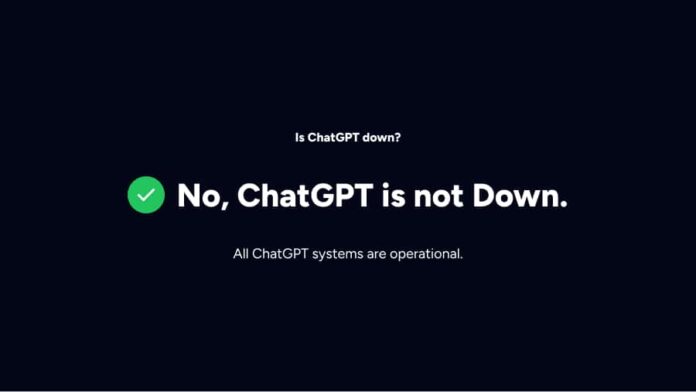It’s a scenario no one wants to face: ChatGPT down in the middle of your most important task. Yet on June 10, 2025, that’s exactly what happened. Users across the world began reporting issues with ChatGPT, including login failures, blank responses, and voice functionality glitches. Whether you’re a casual user or someone whose workflow depends on ChatGPT, the disruption came with widespread frustration and confusion. In this blog, we break down the most recent updates, what might be causing these outages, and how to stay productive when ChatGPT isn’t working.
Sudden Disruption: ChatGPT Down Globally Today
At approximately 8:00 AM Pacific Time, reports began flooding in from users in North America, Europe, and parts of Asia noting they were unable to access ChatGPT. Errors included “Something went wrong,” frozen prompts, and complete inability to load the platform. Social media buzzed with questions, memes, and growing concern as #ChatGPTDown started trending within hours.
This wasn’t just a glitch. Users of both the web interface and API services were affected. Those using ChatGPT for tasks like coding, content writing, research, and customer service automation were left scrambling. Even newer features like voice conversations and file uploads were down.
This marks one of the largest disruptions in recent months, affecting both free and Plus users across the board.
What We Know About the ChatGPT Down Issue
So far, there has been no detailed technical explanation from OpenAI, but patterns from previous outages give us some idea of what could be happening. Typically, ChatGPT outages are tied to the backend infrastructure that supports the large language model, including:
- Server overloads due to sudden spikes in traffic
- Cloud service issues from hosting partners
- Updates or internal changes gone wrong
- Problems with new feature rollouts (e.g., voice, file tools)
Given that voice tools, file uploads, and the core model are all struggling at once, this points to a broader system-level issue rather than a minor UI bug.
How ChatGPT Down Impacts Different Users
This outage has immediate effects on a wide range of users. Here’s how various groups have been impacted:
Content Creators
Writers and marketers using ChatGPT to brainstorm, draft, or optimize content are facing delays. Many rely on the tool to meet daily output goals.
Developers
Software engineers using the Code Interpreter or advanced GPT-4 tools have reported failed outputs, API timeouts, and productivity loss.
Businesses
Startups and customer-facing services using the API to power chatbots or analytics tools are seeing user-facing errors and performance dips.
Students and Teachers
Educators using ChatGPT for tutoring, generating questions, or simplifying complex topics have lost access during crucial academic sessions.
What To Do When ChatGPT Down Hits Again
Even though this outage may be temporary, it’s wise to prepare for future downtime. Here are some proactive steps you can take:
- Bookmark the Status Page: Always check ChatGPT’s operational status first. This confirms if it’s a personal issue or a platform-wide problem.
- Use Alternative Tools: Platforms like Claude, Gemini, and other AI writing assistants can serve as temporary stand-ins.
- Keep Local Copies: If you’re working on a big project, always keep offline backups in case of sudden service interruptions.
- Schedule Around Peak Hours: Use ChatGPT during off-peak hours to avoid traffic-related lags or crashes.
- Stay Informed: Follow official channels or trusted forums for real-time updates and recovery timelines.
Lessons from Today’s ChatGPT Down Episode
This outage serves as a clear reminder that even the most advanced AI tools aren’t immune to downtime. With growing dependence on digital assistants like ChatGPT, it’s crucial to diversify your tech stack and plan for unexpected outages.
It also opens the door to a conversation about infrastructure reliability, transparency from AI providers, and user rights during service disruptions. Users expect more than a generic “we’re looking into it.” They deserve timely updates and clear recovery plans—especially when productivity, learning, and business depend on uninterrupted access.
Is AI Too Centralized?
One question worth asking is whether we’re relying too heavily on a single platform. When ChatGPT goes down, much of the AI-powered internet stalls. This incident highlights the need for more decentralized, interoperable AI systems. Having multiple tools available—especially open-source options—can reduce overdependence on one provider and improve resilience.
Moving Forward
While today’s outage is likely temporary, it’s a wake-up call for businesses and individuals alike. Expecting 100% uptime from any cloud-based service isn’t realistic. But having a plan in place for when outages occur can help reduce stress, save time, and protect your workflow.
Stay flexible, explore alternatives, and be ready to switch gears when necessary. Most importantly, remain calm. Outages happen—but so do recoveries.
Want tips on building AI redundancy into your daily operations or business workflows? Reach out to learn how to stay future-ready in a world of rapid tech shifts.
